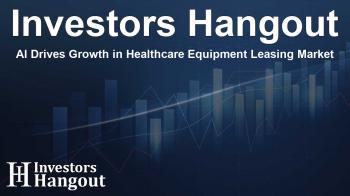AI Drives Growth in Healthcare Equipment Leasing Market

AI Drives Growth in Healthcare Equipment Leasing Market
The global healthcare equipment leasing market is on the fast track to success, showing an expected growth of USD 28.41 billion from 2024-2028. This robust growth stems from several driving factors, particularly the rising high costs of healthcare equipment. Organizations are increasingly looking at equipment leasing as a cost-effective solution to acquire essential medical devices, rather than making high upfront purchases.
Market Drivers
Flexible Financial Solutions for Medical Equipment
Healthcare providers are turning towards leasing models that offer flexible financing options for a wide range of medical equipment. Essential items like MRI machines, CT scanners, X-ray machines, surgical devices, and ventilation equipment are now more accessible through various leasing arrangements. With preventive healthcare gaining momentum, the necessity for cutting-edge medical technology is paramount, making leasing an ideal solution to fulfill these needs.
This trend toward equipment leasing is also influenced by the increasing cost of quality care and the importance of maintaining state-of-the-art equipment. As healthcare facilities strive to meet the growing demand for high-quality services while managing budgets, leasing provides a practical and financially sound approach. Additionally, many tenants benefit from added services such as 24/7 support and maintenance options, ensuring the equipment remains in optimal working condition.
Challenges in Equipment Leasing
Navigating Complex Leasing Agreements
Despite the advantages, healthcare providers encounter multiple challenges when leasing medical equipment. Navigating through the diversity of leasing models can often feel complex. Factors like chronic diseases, healthcare regulations, and equipment obsolescence create obstacles that necessitate careful consideration and planning on the part of providers. Understanding the terms of leasing agreements, including tenant responsibilities and payment timelines, is crucial for successful negotiations.
Moreover, financial implications arise as healthcare providers work to manage their equipment expenditures effectively while ensuring that they meet compliance regulations and maintain high care standards. In addition, the rising popularity of refurbished medical equipment presents yet another challenge, as many providers prefer these lower-cost options, sometimes undermining the leasing market.
Market Segmentation and Trends
End-user Segmentation
The leasing market is diversified across several end-users, including hospitals, diagnostic centers, and private clinics, all of which play a crucial role in the market dynamics. Hospitals, especially smaller facilities, are major consumers in this market segment. These entities seek cost-effective solutions to upgrade their equipment without incurring significant capital investments, making leasing an attractive alternative.
Additionally, partnerships between hospitals and leasing companies enable advanced diagnostic capabilities crucial for patient care, enhancing the overall service offerings of healthcare establishments.
The Future of Healthcare Leasing
Predicted Growth Trends
The future appears bright for the healthcare equipment leasing market, fueled by technological advancements and innovative business models. AI is playing an instrumental role in transforming how healthcare facilities manage their leasing requirements by streamlining operations and improving decision-making. As the leasing industry surpasses a trillion-dollar valuation, the projected growth is poised to attract a multitude of market players eager to capitalize on these emerging opportunities.
Technological enhancements are facilitating seamless interactions between equipment providers and healthcare services, propelling demand for medical devices to new heights. The integration of AI will further aid in identifying market trends, improving customer engagement, and providing actionable insights necessary for sustained growth.
Frequently Asked Questions
What is driving growth in the healthcare equipment leasing market?
Growth is driven by rising equipment costs and the need for cost-effective solutions, alongside advancements in technology such as AI.
What challenges do healthcare providers face in leasing?
Providers often struggle with complex leasing agreements and the balancing act of managing equipment costs while ensuring care quality.
Who are the primary users of leased medical equipment?
The primary users include hospitals, diagnostic centers, and private clinics seeking to upgrade their medical devices without high upfront costs.
How has AI influenced equipment leasing?
AI has streamlined operations, improving decision-making processes and aiding in market trend identification, thus fostering growth.
What types of equipment are commonly leased?
Commonly leased equipment includes MRI machines, CT scanners, surgical devices, and ventilators among others, catering to diverse healthcare needs.
About The Author
Contact Lucas Young privately here. Or send an email with ATTN: Lucas Young as the subject to contact@investorshangout.com.
About Investors Hangout
Investors Hangout is a leading online stock forum for financial discussion and learning, offering a wide range of free tools and resources. It draws in traders of all levels, who exchange market knowledge, investigate trading tactics, and keep an eye on industry developments in real time. Featuring financial articles, stock message boards, quotes, charts, company profiles, and live news updates. Through cooperative learning and a wealth of informational resources, it helps users from novices creating their first portfolios to experts honing their techniques. Join Investors Hangout today: https://investorshangout.com/
The content of this article is based on factual, publicly available information and does not represent legal, financial, or investment advice. Investors Hangout does not offer financial advice, and the author is not a licensed financial advisor. Consult a qualified advisor before making any financial or investment decisions based on this article. This article should not be considered advice to purchase, sell, or hold any securities or other investments. If any of the material provided here is inaccurate, please contact us for corrections.

